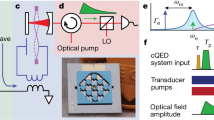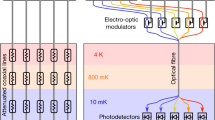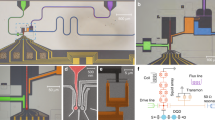Abstract
Conversion of electrical and optical signals lies at the foundation of the global internet. Such converters are used to extend the reach of long-haul fibre-optic communication systems and within data centres for high-speed optical networking of computers. Likewise, coherent microwave-to-optical conversion of single photons would enable the exchange of quantum states between remotely connected superconducting quantum processors1. Despite the prospects of quantum networking2, maintaining the fragile quantum state in such a conversion process with superconducting qubits has not yet been achieved. Here we demonstrate the conversion of a microwave-frequency excitation of a transmon—a type of superconducting qubit—into an optical photon. We achieve this by using an intermediary nanomechanical resonator that converts the electrical excitation of the qubit into a single phonon by means of a piezoelectric interaction3 and subsequently converts the phonon to an optical photon by means of radiation pressure4. We demonstrate optical photon generation from the qubit by recording quantum Rabi oscillations of the qubit through single-photon detection of the emitted light over an optical fibre. With proposed improvements in the device and external measurement set-up, such quantum transducers might be used to realize new hybrid quantum networks2,5 and, ultimately, distributed quantum computers6,7.
This is a preview of subscription content, access via your institution
Access options
Access Nature and 54 other Nature Portfolio journals
Get Nature+, our best-value online-access subscription
$29.99 / 30 days
cancel any time
Subscribe to this journal
Receive 51 print issues and online access
$199.00 per year
only $3.90 per issue
Buy this article
- Purchase on Springer Link
- Instant access to full article PDF
Prices may be subject to local taxes which are calculated during checkout




Similar content being viewed by others
Data availability
The data that support the findings of this study are available from the corresponding author (O.P.) upon reasonable request.
References
Arute, F. et al. Quantum supremacy using a programmable superconducting processor. Nature 574, 505–510 (2019).
Briegel, H., Dür, W., Cirac, J. I. & Zoller, P. Quantum repeaters: the role of imperfect local operations in quantum communication. Phys. Rev. Lett. 81, 5932–5935 (1998).
O’Connell, A. D. et al. Quantum ground state and single-phonon control of a mechanical resonator. Nature 464, 697–703 (2010).
Meenehan, S. M. et al. Pulsed excitation dynamics of an optomechanical crystal resonator near its quantum ground state of motion. Phys. Rev. X 5, 041002 (2015).
Muralidharan, S. et al. Optimal architectures for long distance quantum communication. Sci. Rep. 6, 20463 (2016).
Monroe, C. et al. Large-scale modular quantum-computer architecture with atomic memory and photonic interconnects. Phys. Rev. A 89, 022317 (2014).
Fitzsimons, J. F. Private quantum computation: an introduction to blind quantum computing and related protocols. npj Quantum Inf. 3, 23 (2017).
Devoret, M. H. & Schoelkopf, R. J. Superconducting circuits for quantum information: an outlook. Science 339, 1169–1174 (2013).
Kimble, H. J. The quantum internet. Nature 453, 1023–1030 (2008).
O’Brien, J. L., Furusawa, A. & Vuckovic, J. Photonic quantum technologies. Nat. Photon. 3, 687–695 (2009).
Reagor, M. et al. Reaching 10 ms single photon lifetimes for superconducting aluminum cavities. Appl. Phys. Lett. 102, 192604 (2013).
Fan, L. et al. Superconducting cavity electro-optics: a platform for coherent photon conversion between superconducting and photonic circuits. Sci. Adv. 4, eaar4994 (2018).
Hisatomi, R. et al. Bidirectional conversion between microwave and light via ferromagnetic magnons. Phys. Rev. B 93, 174427 (2016).
O’Brien, C., Lauk, N., Blum, S., Morigi, G. & Fleischhauer, M. Interfacing superconducting qubits and telecom photons via a rare-earth-doped crystal. Phys. Rev. Lett. 113, 063603 (2014).
Lambert, N. J., Rueda, A., Sedlmeir, F. & Schwefel, H. G. L. Coherent conversion between microwave and optical photons—an overview of physical implementations. Adv. Quantum Technol. 3, 1900077 (2020).
Teufel, J. D. et al. Sideband cooling of micromechanical motion to the quantum ground state. Nature 475, 359–363 (2011).
Chan, J. et al. Laser cooling of a nanomechanical oscillator into its quantum ground state. Nature 478, 89–92 (2011).
Bochmann, J., Vainsencher, A., Awschalom, D. D. & Cleland, A. N. Nanomechanical coupling between microwave and optical photons. Nat. Phys. 9, 712–716 (2013).
Andrews, R. W. et al. Bidirectional and efficient conversion between microwave and optical light. Nat. Phys. 10, 321–326 (2014).
Bagci, T. et al. Optical detection of radio waves through a nanomechanical transducer. Nature 507, 81–85 (2014).
Balram, K. C., Davanço, M. I., Song, J. D. & Srinivasan, K. Coherent coupling between radiofrequency, optical and acoustic waves in piezo-optomechanical circuits. Nat. Photon. 10, 346–352 (2016).
Forsch, M. et al. Microwave-to-optics conversion using a mechanical oscillator in its quantum groundstate. Nat. Phys. 16, 69–74 (2020).
Higginbotham, A. P. et al. Harnessing electro-optic correlations in an efficient mechanical converter. Nat. Phys. 14, 1038–1042 (2018).
Zeuthen, E., Schliesser, A., Sørensen, A. S. & Taylor, J. M. Figures of merit for quantum transducers. Preprint at https://arXiv.org/1610.01099v2 (2017).
Aspelmeyer, M., Kippenberg, T. J. & Marquardt, F. Cavity optomechanics. Rev. Mod. Phys. 86, 1391–1452 (2014).
Chu, Y. et al. Quantum acoustics with superconducting qubits. Science 358, 199–202 (2017).
Arrangoiz-Arriola, P. et al. Resolving the energy levels of a nanomechanical oscillator. Nature 571, 537–540 (2019).
Hong, S. et al. Hanbury Brown and Twiss interferometry of single phonons from an optomechanical resonator. Science 358, 203–206 (2017).
Keller, A. J. et al. Al transmon qubits on silicon-on-insulator for quantum device integration. Appl. Phys. Lett. 111, 042603 (2017).
Chan, J., Safavi-Naeini, A. H., Hill, J. T., Meenehan, S. & Painter, O. Optimized optomechanical crystal cavity with acoustic radiation shield. Appl. Phys. Lett. 101, 081115 (2012).
Fang, K., Matheny, M. H., Luan, X. & Painter, O. Optical transduction and routing of microwave phonons in cavity-optomechanical circuits. Nat. Photonics 10, 489–496 (2016).
Cohen, J. D. et al. Phonon counting and intensity interferometry of a nanomechanical resonator. Nature 520, 522–525 (2015).
Johnson, M. Direct real time measurement of quasiparticle lifetimes in a superconductor. Phys. Rev. Lett. 67, 374–377 (1991).
Borselli, M., Johnson, T. J. & Painter, O. Measuring the role of surface chemistry in silicon microphotonics. Appl. Phys. Lett. 88, 131114 (2006).
Ren, H. et al. Two-dimensional optomechanical crystal cavity with high quantum cooperativity. Nat. Commun. 11, 3373 (2020).
Qiu, L., Shomroni, I., Seidler, P. & Kippenberg, T. J. Laser cooling of a nanomechanical oscillator to its zero-point energy. Phys. Rev. Lett. 124, 173601 (2020).
MacCabe, G. S. et al. Nano-acoustic resonator with ultralong phonon lifetime. Science 370, 840–843 (2020).
Wang, C. et al. Measurement and control of quasiparticle dynamics in a superconducting qubit. Nat. Commun. 5, 5836 (2014).
Acknowledgements
We thank M. Shaw, J. Banker, H. Ren, E. Kim and X. Zhang for their various contributions to this work. This work was supported by the ARO/LPS Cross Quantum Technology Systems programme (grant W911NF-18-1-0103), the Institute for Quantum Information and Matter, an NSF Physics Frontiers Center (grant PHY-1125565) with support of the Gordon and Betty Moore Foundation, and the Kavli Nanoscience Institute at Caltech. M.M (A.S.) acknowledges support from a KNI (IQIM) Postdoctoral Fellowship.
Author information
Authors and Affiliations
Contributions
All authors contributed to the concept and planning of the experiment, the device design and fabrication, the measurements and analysis of data, and the writing of the manuscript.
Corresponding author
Ethics declarations
Competing interests
The authors declare no competing interests.
Additional information
Peer review information Nature thanks Konrad Lehnert and the other, anonymous, reviewer(s) for their contribution to the peer review of this work. Peer review reports are available.
Publisher’s note Springer Nature remains neutral with regard to jurisdictional claims in published maps and institutional affiliations.
Extended data figures and tables
Extended Data Fig. 1 Device fabrication process.
(i) Starting substrate: AlN-on-SOI. (ii) Defining the boundaries of the piezoelectric resonator with plasma etching. (iii) Deposition of silicon oxide protective mask. (iv) Patterning of the silicon oxide mask with plasma etching. (v) Removing the AlN layer outside the device boundaries with phosphoric acid wet etch. (vi) Removing the silicon oxide mask with a BHF acid wet etch. (vii) Patterning of the silicon device layer with plasma etching. (viii) Evaporation of aluminium for IDT, qubit capacitor, resonator, CPW and device ground layer. (ix) Angled evaporation of Josephson junction leads. (x) Vapour-HF etch of buried oxide layer for releasing the device membrane. Images are not to scale. All patterning is performed with electron beam lithography using a ZEP-520A electron beam resist mask.
Extended Data Fig. 2 Optomechanical and piezoelectric design.
a, Simulated mechanical mode shape (deformation) and electric voltage (colour) of the piezoacoustic cavity mode of interest with an IDT period of 930 nm and a beam width of 600 nm. b, Simulated optical (top) and mechanical (bottom) mode profile of an OMC designed with the mechanical mode near 5 GHz. c, Simulated optical (top) and mechanical (bottom) mode profile of the full piezo-optomechanical transducer device formed by attaching the piezoacoustic cavity of (a) and the OMC cavity of (b) through a phonon waveguide section in which the mirror holes in the OMC cavity are modified nearest the piezoacoustic cavity. The optomechanical and piezoelectric coupling rates listed are calculated for the hybridized mode with the largest optomechanical coupling. d, Radii of the patterned holes along the nanobeam OMC cavity and phonon waveguide section. d1 (d2) designates the hole diameter normal (parallel) to the nanobeam’s long axis. The optical cavity region (shaded 13 central holes) is located between a phonon/photon mirror (left seven holes) and a photon mirror/phonon waveguide section (right seven holes).
Extended Data Fig. 3 Design of the phonon waveguide unit cell.
a, Schematics of the original (top) and modified (bottom) unit cell of the OMC cavity mirror section adjacent to the phonon waveguide. The dimensional parameters are equal to d1 = 366 nm (d1 = 295 nm) and d2 = 205 nm (d2 = 320 nm) for the original (modified) holes. The nanobeam parameters (h = 220 nm, a = 436 nm, b = 529 nm) are identical for both cases. b, Simulated mechanical band structures. The dashed line marks a nominal mechanical resonance frequency of fm = 5.3 GHz for the decoupled OMC and piezoacoustic cavity modes. The intersection of the dashed line and the energy band in the bottom acoustic band-structure plot for the modified hole structure allows for guiding of acoustic waves between the piezoacoustic and OMC cavity. c, Optical band structure for TE-like modes of the OMC cavity, again with the top plot being for the original OMC cavity and the bottom plot for the OMC cavity with modified holes. The solid black line marks the light line, and the dashed line refers to a nominal optical resonance frequency of the fundamental mode of the OMC cavity at a frequency fo = 193 THz. Unlike the acoustic mode case, the hole modifications in the OMC cavity actually increase the optical bandgap, further suppressing optical radiation into the phonon waveguide.
Extended Data Fig. 4 Mechanical mode hybridization.
Optomechanical and piezoelectric coupling rates from COMSOL Multiphysics simulations of the integrated piezo-optomechanical transducer consisting of a piezoacoustic cavity connected by a phonon waveguide to the OMC cavity (see Fig. 1b). Each resonant acoustic mode of the simulated structure is plotted as a ‘pin’ in each plot, with the horizontal axis corresponding to the resonant mode frequency, ωm/2π. The period of the IDT has been varied along with the total length of the piezoacoustic cavity (that is, fixed total number of periods and exterior boundary region to AlN box), leading to an approximate linear change in the frequency of the mechanical modes with IDT period. The OMC cavity and phonon waveguide parameters are identical for all of the plots.
Extended Data Fig. 5 Transduction measurement set-up.
Simplified diagram of the experimental set-up used for low-temperature piezoelectric and optomechanical device characterization. The laser emission is passed through a 50-MHz bandwidth filter to suppress broadband spontaneous emission noise. The optical readout pulses are generated using high-extinction modulation components (AOM, Ag.). Microwave pulses are synthesized using arbitrary waveform generators at intermediate frequency band (IF, <500 MHz) and up-converted using mixers and microwave sources to the gigahertz frequency band. Readout of microwave signals is performed using an analogue-to-digital converter after down-conversion to IF band. The optical modulation and microwave synthesis/readout components are triggered by a digital delay generator. Upon reflection from the device under test (DUT), a fibre optical circulator routes the outgoing light to either an EDFA and spectrum analyser, or a sideband-filtering bank consisting of three cascaded fibre Fabry–Perot filters (Micron Optics FFP-TF2) and the SPD operated at ~760 mK. Electrical (optical) signal/control line shown in black (blue). λ-meter: wavemeter; ϕ-m: electro-optic phase modulator; Ag., Agiltron 1 × 1 MEMS switch; AOM, acousto-optic modulator; EDFA, erbium-doped fibre amplifier; SPD, single photon detector; SW, optical 2 × 2 switch; TCSPC, time-correlated single photon counting module (PicoQuant PicoHarp 300); VOA, variable optical attenuator; VNA, vector network analyser.
Extended Data Fig. 6 Laser-induced heating.
Plot of the measured thermal noise in the mechanical mode (red) and optomechanical readout efficiency (blue) as a function of integration time (τro). Here the noise and efficiency are calibrated from measurements of the optomechanical sideband asymmetry. As for the transduction measurements, the optical pump power is set to Pin = 2 μW at the optical input fibre to the dilution refrigerator, which corresponds to an estimated intra-cavity photon number of nc = 44 and an optomechanical readout rate of \({\gamma }_{{\rm{om}}}=4{g}_{{\rm{om}}}^{2}/{\kappa }_{{\rm{o}}}=2{\rm{\pi }}\,\times \,(19\,{\rm{kHz}})\). The measurement sequence contains no microwave drive, with the qubit detuned from the mechanical mode, and contains a 250-μs delay between consecutive optical readout pulses to ensure relaxation of the mechanical mode occupancy to its base-temperature value (≪1) with the laser off. The error bars mark the standard deviation at each point, which is calculated by using the raw counts, assuming Poissonian shot noise. For comparison to the transduction measurements presented in Fig. 4, the operational readout window of τro = 38 ns (marked with the vertical dashed line) yields a photon detection efficiency of pd = 8.8 ± 1.3 × 10−6 (horizontal blue dashed line) and a thermal noise of nm = 0.64 ± 0.15 phonons (horizontal red dashed line).
Extended Data Fig. 7 Light-induced QP generation.
Plot of the qubit Rabi contrast measured when the transmon qubit is driven with a variable-length microwave drive after illumination by an optical pulse (Rabi oscillation period 150 ns). The horizontal axis marks the separation between incident optical pulse and the beginning of the Rabi measurement. The optical pulse duration is τpulse = 100 ns and the pulse repetition rate is R = 10 Hz. The peak optical power of the pulses corresponds to Pin = 40 μW at the input fibre to the dilution refrigerator. Vortex trapping is done with a cooling magnetic field estimated to be 15 G at the chip.
Rights and permissions
About this article
Cite this article
Mirhosseini, M., Sipahigil, A., Kalaee, M. et al. Superconducting qubit to optical photon transduction. Nature 588, 599–603 (2020). https://doi.org/10.1038/s41586-020-3038-6
Received:
Accepted:
Published:
Issue Date:
DOI: https://doi.org/10.1038/s41586-020-3038-6
This article is cited by
-
An integrated microwave-to-optics interface for scalable quantum computing
Nature Nanotechnology (2024)
-
Continuous wideband microwave-to-optical converter based on room-temperature Rydberg atoms
Nature Photonics (2024)
-
Non-classical microwave–optical photon pair generation with a chip-scale transducer
Nature Physics (2024)
-
Room-temperature phonon-coupled single-photon emission in hexagonal boron nitride
Science China Physics, Mechanics & Astronomy (2024)
-
Dynamical Casimir effect in a hybrid cavity optomechanical system
Quantum Information Processing (2024)
Comments
By submitting a comment you agree to abide by our Terms and Community Guidelines. If you find something abusive or that does not comply with our terms or guidelines please flag it as inappropriate.



